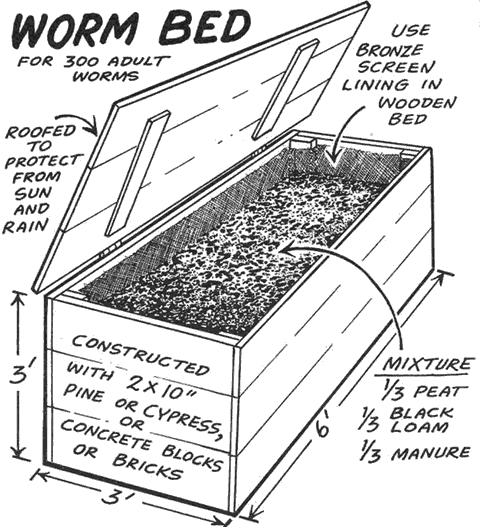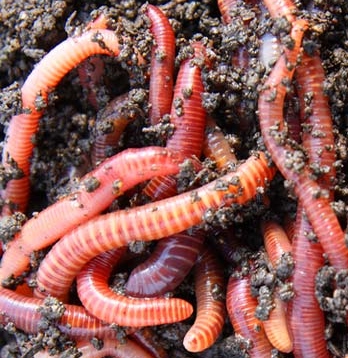Get This Report on Where To Find Red Wigglers
Wiki Article
How Where To Find Red Wigglers can Save You Time, Stress, and Money.
Table of ContentsThe Basic Principles Of Where To Find Red Wigglers See This Report about Where To Find Red WigglersAll about Where To Find Red WigglersSome Known Incorrect Statements About Where To Find Red Wigglers Excitement About Where To Find Red WigglersThe Basic Principles Of Where To Find Red Wigglers
For ideal outcomes, you want to shoot for regarding 60-70% moisture degree. At the ideal dampness degrees which is simply under 70% that handful should hardly generate one drop of fluid.
The Indian Blue is ravenous, but additionally prefers a warmer environment and it likewise shows a propensity to escape the bin. The red wiggler is a durable worm and isn't as picky concerning its climate. I like to call it the Ford Taurus of vermicomposting worms; you will not boast to your hardcore composting friends that you have them, however they will serve you well.
As Tap showed, an angler can do a good offer to make a worm much more appealing.
Where To Find Red Wigglers for Dummies
I think you will certainly as well if you attempt them. The smaller the trout stream, the far better worms work is an axiom that hasn't altered in the 100-plus years given that Perry created his post. Anglers of his period merely stuck their weak fly rods with alder tangles and dropped a heavy worm right into a deep opening.Early morning is prime feeding time, and the insubstantial lure's sluggish descent leaves 5 inches of agonizing protein in full sight for a long time. After you have actually made the cast, keep the bond open and put the pole in a forked stick. The line will diminish the rod in sluggish loops as the worm resolves, however a lot more often than not the slow-moving loops will come to be a blur, and the early morning will unexpectedly get rather fascinating.
You can fish deep and cover a great deal of territory, and the spider seems to be the excellent touch for this transitional time, when the smallmouths have yet to secure on to a favored forage. Dark jigsblack, brown, and purpleseem to match the nightcrawler's shade. I normally utilize an entire 'crawler, prefer marabou dressing, and drop the rod for 2 or 3 secs when I get a hit.
And identifying bottom from a bite can be challenging. The trick is to ease the rod back to the strike (perhaps a foot) and feel for life at the end of the tightening line. If it exists, set the hook with a move instead than a jerk. When in a while you'll discover yourself hooked to those slow, passionate yanks, and really feel the weight of a good walleye.
What Does Where To Find Red Wigglers Mean?
When the heavy walleyes carry on to the big-water shoals in the late summertime, attempt pursuing them with a bucktail jig and a 1-inch pinch of nightcrawler. The bait covers the hook factor, deflects weeds, and supplies a taste of prey. With nothing dangling or flapping, it continues to be safe no matter of current, casts, or enthusiastic panfish.Whether you're wading or angling from a boat, drifting worms is among the wonderful searching methods for bigger rivers. For trout, a spade-dug, 4-inch garden worm is the ideal size; for bass, walleyes, and steelhead, a nightcrawler may be a far better selection. The secret is to wander the lure with feeding and holding areas because fish in current are not mosting likely to chase down the lure, as they might in still water.
Fish the changes: mouths of tributaries, bank-side slicks, and the sides of huge swimming pools. His rule uses to any kind of their website number of angling maneuvers, including the matter of adding an item of worm to a damp fly.

Where To Find Red Wigglers Fundamentals Explained
Load it with shredded paper, leaves, peat moss, and dirt. Moisten gently. Cover and allow rest for a week. Add a few hundred worms and feed them 2 times a week. Keep the bed linen damp however not wet. On the food selection: lettuce, fruit and vegetable waste, and the occasional nongreasy extra.Similar to veggie scraps, you can take your made use of coffee grounds and add them to a worm box. Worms love directory eating coffee premises. With the ideal problems and wet, healthy soil, worms can reside in a pail of dust for around three weeks. Shop out of direct sunshine and maintain a temperature between 50 and 80 levels.
When the hefty walleyes proceed to the big-water shoals in the late summer season, try going after them with a bucktail jig and a 1-inch pinch of nightcrawler. The bait covers the hook factor, disperses weeds, and uses a taste of prey. With nothing dangling or flapping, it remains safe regardless of current, casts, or enthusiastic panfish.
Some Ideas on Where To Find Red Wigglers You Need To Know
Whether you're wading or angling from a boat, wandering worms is just one of the fantastic searching strategies for bigger rivers. Where To Find Red Wigglers. For trout, a spade-dug, 4-inch garden worm is the right dimension; for bass, walleyes, and steelhead, a nightcrawler might be a better selection. The secret is to drift the lure through feeding and holding locations since fish in present are not mosting likely to ferret out the bait, as they may in still waterStrikes will come as a sharp tug as opposed to a pull or rap. Fish the shifts: mouths of tributaries, bank-side slicks, and the edges of huge pools. As the late Ed Zern, Area & Stream's terrific satirist, once placed it: Fishermens are birthed honest but they overcome it. His dictum applies to any number of angling maneuvers, including the issue of adding an item of worm to a damp fly.
Raising your own bait indicates you can slide out of the house and struck the fish pond prior to Mama comes homejust Where To Find Red Wigglers like in the old days. Here's how to keep a worm box: Cut a sheet of CDX-grade plywood, which is made with waterproof adhesives, to your dimensions. Toenail it with each other and pierce a lots 12-inch openings in all-time low for water drainage.
Getting The Where To Find Red Wigglers To Work
Fill it with shredded newspaper, leaves, peat moss, and soil. Moisten gently. Cover and allow sit for a week. Include a couple of hundred worms and feed them two times a week. Keep the bed linens damp however not damp. On the menu: lettuce, vegetables and fruit waste, and the occasional nongreasy extra.Similar to veggie scraps, you can take your used coffee grounds and include them to a worm box. Worms like consuming coffee grounds. With the right conditions and damp, healthy dirt, worms can live in a bucket of dust for around three weeks. Store out of straight sunlight and maintain at a temperature level between 50 and 80 levels.
Report this wiki page